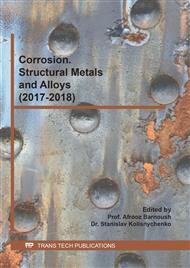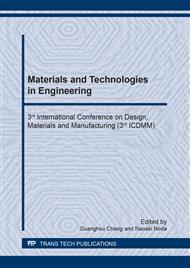p.35
p.40
p.46
p.53
p.59
p.65
p.72
p.79
p.84
Effect of Cl- Concentration on Pitting Corrosion Property of Maraging Hardened Stainless Steel Based on Pourbaix Diagram
Abstract:
The corrosion behavior of maraging hardened stainless steel (MHSS) in different Cl- medium was investigated by thermodynamics simulation and electrochemical experiments. The simulation results show that the thermodynamic stability zone decreases with the increase of the concentration of Cl-. Some of chromium transformed into Cr(OH)2+ and adsorbed on the surface of stainless steel, and others generated Cr2O3 protecting the matrix. Mo reacted with O2 to form MoO42- adsorbed on the surface of the material, which inhibited the destruction of Cl-. The electrochemical experiments indicate that the concentration of Cl- is in the range of 2%-7%. The pitting potential and self-corrosion potential of MHSS decreased linearly with the increase of ion concentration, and the pitting corrosion resistance of MHSS decreased. When the self-corrosion current increases from 1.9888 μA to 2.6524 μA, the corrosion tendency of the material enhances.
Info:
Periodical:
Pages:
59-64
Citation:
Online since:
December 2018
Authors:
Price:
Сopyright:
© 2018 Trans Tech Publications Ltd. All Rights Reserved
Share:
Citation:



